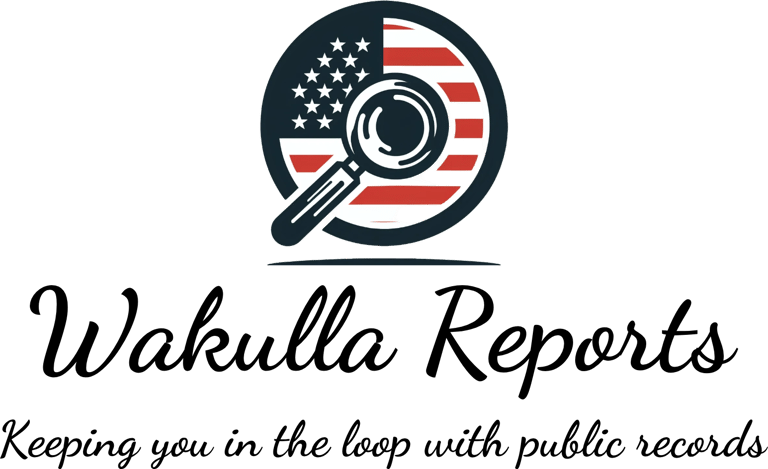Wakulla’s $5.89 Million COVID Relief: Where Did It Go, and Where’s the Money Now?
Uncovering Wakulla County’s $5.89M CARES Act spending, where only 7.1% reached citizens while millions went to bureaucracy, raising questions about missing records and replaced budget funds.
MONEY & FINANCE2025
Virginia Hall
6/28/20256 min read


When a Wakulla Reports contributor requested records to uncover how Wakulla County spent its $5,887,195 in CARES Act funds—meant to support public health, small businesses, and residents during the COVID-19 crisis—they expected a clear accounting, as required by the CARES Act Funding Agreement (Section 9). Instead, the State of Florida provided records at no cost, while the county charged over $60 for a convoluted, incomplete mess that inflates spending by $4.3 million and omits critical payroll spreadsheets. The county, responsible for detailed record-keeping (Section 9), claimed the person handling these records no longer works there, leaving staff scrambling. The data shows a shocking imbalance: we have estimated that just 7.1% reached citizens, while 96.8% went to bureaucracy, including millions for the entire Sheriff’s Office payroll, not just COVID-related costs. Five years later, with the county running a cash deficit (per our audit report blog series), where did the budget funds—freed up by CARES Act money—go? If Wakulla County is on the up and up, it’s time to publish all COVID-19 relief records—payroll spreadsheets, contracts, and every penny spent—for public and auditor review, and request an audit from the Florida Auditor General to ensure accountability.
A $4.3 Million Discrepancy
The Florida Division of Emergency Management’s (FDEM) closeout notice confirms Wakulla County received and spent $5,887,195 in CARES Act funds across three phases: $1,471,799 (Phase 1), $1,177,439 (Phase 2), and $3,237,957 (Phase 3). Yet, the county’s backup documentation, provided after our contributor’s public records request (and a $60+ fee), lists reimbursement requests (RFRs) and advances (RAVs) totaling $10,171,150.37—$4.3 million more than the allocation. The Funding Agreement (Section 8) requires accurate reimbursement requests with supporting documentation, yet the county’s records show inconsistencies and omissions. Here’s what our contributor found, tied to the agreement’s requirements:
Sheriff’s Office Payroll Overlap (Section 7h, 7i.iii): An unnumbered RFR claims $5,180,103 for the entire Sheriff’s Office payroll—not just the portion tied to increased COVID-19 services—likely duplicating RFR 5462 ($3,237,957) and RAV 4828 ($807,873), both for March–September 2020. This double-counting inflates the total. The Funding Agreement (Section 7h) allows payroll only for expenses “necessary” for the COVID-19 emergency and unbudgeted as of March 27, 2020, and Section 7i.iii limits it to employees “substantially dedicated” to COVID response. Without proof of COVID-specific duties in missing spreadsheets, who knows if this actually qualified?(Section 7g).
Vague Administrative Costs (Section 9): RFR 5042 ($8,305.78) covers 157 hours by a county official for “CARES Act management,” but lacks task details—odd, since Integrity Group was hired for administration. RFR 5052 requests $534,126.26 for Integrity Group’s consulting, including a $429,437.50 estimate with no documentation and vague tasks like “meetings” at $175–$185/hour. Section 9 requires detailed records for all expenditures, yet the lack of supporting documentation muddies transparency.
Weak Small Business Grants Process (Section 7i.v, 9): RFR 5062 ($50,000) funded grants, including $15,000 to a local citizen who sits on the Economic Development Council and owns two businesses. The approval process relied on a basic spreadsheet anyone could make, with no financial data or robust vetting, raising concerns about oversight. Section 7i.v allows economic support for COVID-impacted businesses, but Section 9 mandates clear records to justify eligibility, which the flimsy process lacks.
Missing Documentation (Section 9): RFR 5323 ($316,948) for the “Keep Wakulla Working” training program and RFR 5365 ($50,631.40) for resident assistance (rent, utilities, medical, funeral costs) lack contracts or receipts. Section 9 requires detailed records accessible to the public, and their absence clouds accountability.
Unsubstantiated Estimates (Section 8, 7g): Large estimates—like $710,000 for Fire and Rescue payroll (RFR 5419) and $1,796,390 for Sheriff’s Office payroll (unnumbered RFR)—lack supporting records, including referenced spreadsheets not provided. Section 8 requires documentation for reimbursement requests, and unverified costs risk repayment (Section 7g).
Incomplete Records (Section 9c, 9d): The county omitted smaller RAVs (e.g., $46,247.03, $4,781.95) listed in the closeout, which likely cover the $88,173.63 gap when excluding the unnumbered RFR. The absence of payroll spreadsheets and other records fails to meet Section 9c and 9d, which mandate public access under Florida’s Public Records Law.
Bureaucracy Over “Little People”
The data reveals a stark imbalance: only 7.1% ($417,579.40) of the $5.89 million went to small businesses, residents, and training programs, while up to 96.8% ($5,698,389.97) funded bureaucratic expenses, violating the spirit of the Funding Agreement’s focus on COVID-19 relief (Section 7h). Just $100,631.40 (1.7%) directly supported small business grants and resident assistance, while administrative costs—$851,074.26 to Integrity Group ($534,126.26) and CareerSource Capital Region ($316,948)—nearly doubled that amount. The Sheriff’s Office payroll, covering the entire staff rather than COVID-specific work, consumed up to 88% of the funds, with missing spreadsheets obscuring eligibility (Section 7i.iii). No one disputes the worthiness of our law enforcement officers and EMS personnel, but why was so little focused on citizens? The flimsy spreadsheet-based approval for small business grants, lacking financial rigor (Section 9), further shows the county’s minimal effort to support the “little people”—business owners and residents hit hardest by the pandemic.
Where Did the Replaced Money Go?
By using CARES Act funds to cover the entire Sheriff’s Office payroll (up to $5,180,103) and Fire and Rescue payroll ($710,000), the county likely freed up millions in budgeted funds, as these salaries were already accounted for in the 2020–2021 budget (Section 7h.ii prohibits covering budgeted expenses). Where did that money go? Did it fund infrastructure, reserves, or other priorities? The Funding Agreement (Section 9) requires records to track such expenditures, but the county’s convoluted documentation offers no answers. Five years later, our audit report blog series reveals Wakulla County is running an expendable cash deficit. How can a county that received millions in replacement funds now be low on cash? This raises serious concerns about fiscal management and whether CARES Act funds were used to plug budget holes rather than deliver relief to citizens, muddying the transparency required by Section 9d.
Transparency Falls Short
The county’s response to our contributor’s records request was alarming: they claimed the person who handled CARES Act records no longer works there, forcing staff to scramble to locate them. This is unfair to Wakulla County’s hardworking employees, but it’s unacceptable for managing a $5.89 million public fund under the Funding Agreement’s record-keeping mandate (Section 9). The provided records, totaling $10.17 million, overshoot the allocation by $4.3 million, suggesting sloppy tracking or confusion. Excluding the likely redundant unnumbered RFR, the total drops to $5,799,021.37, leaving an $88,173.63 gap possibly covered by unprovided RAVs. Charging over $60 for incomplete records—while the state provided theirs for free—contrasts with Section 9d’s requirement for public access. The absence of critical payroll spreadsheets and contracts (Section 9) clouds accountability, leaving us to wonder: does the county itself know where the funds went?
A Call for Full Disclosure
If Wakulla County is confident in its spending, there’s a clear path forward: publish all COVID-19 relief records—every payroll spreadsheet, contract, and penny spent—for public and auditor review, as required by Section 9c and 9d. The missing spreadsheets for Sheriff’s Office (RFR 5462, RAV 4828, unnumbered RFR) and Fire and Rescue payrolls (RFR 5419) are critical to proving eligibility under Section 7i.iii. Contracts for the $316,948 training program (RFR 5323) and $534,126.26 in consulting fees (RFR 5052), should be public. The county could also request an audit from the Florida Auditor General, located in Section 10, to confirm funds were spent appropriately, restoring trust. Without this, the murky records, cash deficit, and unanswered question of where replaced budget funds went raise concerns about misplaced priorities. It should be noted that the original requester limited the public records request due to additional fees insinuated by the county, asking for everything submitted to the State of Florida.
Why This Matters
These funds were meant to ease the pain of a pandemic—supporting testing, PPE, small business grants, and struggling families, as outlined in Section 7i. Yet, it is estimated that only 7.1% ($417,579.40) reached community programs, with a mere 1.7% ($100,631.40) for direct aid. Meanwhile, 96.8% ($5,698,389.97) went to bureaucracy, including $851,074.26 for consulting and training with little documentation (Section 9). The entire Sheriff’s Office payroll, potentially ineligible without COVID justification (Section 7h, 7i.iii), and the weak grant process—a spreadsheet anyone could make—suggest the county prioritized institutional costs over the “little people.” Now, with a cash deficit, the question of where the millions in replaced budget funds went looms large. Were they used for roads, sewer, or something else? Section 9 requires a clear accounting, and residents deserve answers. Audits by FDEM, the Florida Auditor General, and the U.S. Treasury OIG (Section 10) could demand repayment for unverified costs (Section 7g), making transparency urgent.
What’s Next?
We may never fully know where all $5.89 million went—or where the millions in replaced budget funds ended up—and the county’s records suggest they might not either. Wakulla Reports is calling for one thing: Wakulla County must publish all CARES Act records, from payroll spreadsheets to contracts, and consider requesting an audit from the Florida Auditor General to ensure every dollar was spent well. We want to hear from you:
Did you receive a small business grant or resident assistance? Was the process fair?
Did you notice Sheriff’s Office or EMS staff tackling COVID-specific tasks, like testing site security?
What do you think the county did with the budget money freed up by CARES Act funds?
Wakulla deserves clarity. If you have tips or experiences with these funds, contact Wakulla Reports @ wakullareports@gmail.com. Let’s demand a full accounting of every penny.

Additional Social Links
YouTube is your go-to for short clips, video explainers, and visual breakdowns of how Florida and Wakulla governments really work.
Facebook brings you bite-sized written content, sticky-note facts, and rolling updates you can share and discuss.
Prefer to browse at your own pace?
Bookmark our website and visit anytime for fresh posts, resources, and real-life examples from right here in Wakulla County.
© 2024. All rights reserved.
